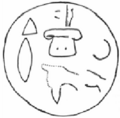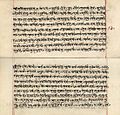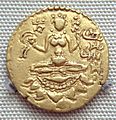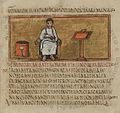Palaeography facts for kids
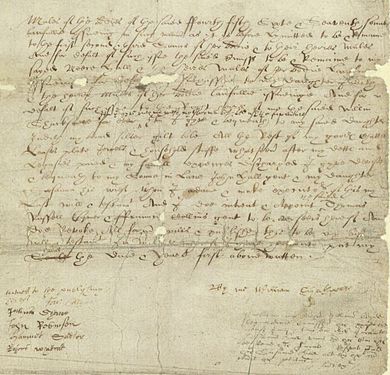
Palaeography (pronounced pay-lee-OG-ruh-fee) is the study of old and historical handwriting. It comes from two ancient Greek words: palaiós, meaning "old," and graphein, meaning "to write."
This field helps us understand how people wrote long ago. Palaeographers learn to read, understand, and figure out the age of old handwritten documents. They also study how writing and books were made in the past, including places called scriptoria where scribes copied texts.
Palaeography is very important for understanding, proving, and dating ancient texts. It helps historians and researchers know if an old document is real and roughly when it was created.
Contents
What Palaeography Is All About
Palaeography is like being a detective for old writing. It focuses on the look of the writing, not just what the words say. Experts in this field study the different styles of letters, how they connect, and the tools used to write them.
Why Study Old Handwriting?
Studying old handwriting is crucial for several reasons:
- Reading Old Documents: Many old documents are hard to read because the handwriting styles are very different from today's. Palaeographers can decipher these old scripts.
- Dating Texts: By looking at the style of writing, experts can often tell when a document was written. Different periods had different popular handwriting styles.
- Authenticating Documents: Palaeography helps confirm if an old document is real or a fake. If the writing style doesn't match the supposed time period, it might be a forgery.
- Understanding History: It gives us clues about the people who wrote these documents and the time they lived in. It shows how writing changed over centuries.
Tools and Techniques of Palaeography
Palaeographers use special skills and knowledge to do their work:
- Deciphering Scripts: They learn to recognize and read many different historical scripts, from ancient Greek to medieval Latin.
- Analyzing Materials: They study the materials used for writing, like papyrus, parchment, or early paper. They also look at the inks and pens.
- Understanding Abbreviations: Old texts often used many abbreviations to save space. Palaeographers know how to expand these shortened words.
- Cultural Context: They consider the culture and time period in which the writing was created. This helps them understand why certain styles or methods were used.
History of Writing Styles
Writing styles have changed a lot over thousands of years. Palaeography covers a huge range of these changes.
Ancient Scripts
In ancient times, different civilizations developed their own unique ways of writing.
- Hieroglyphs: Ancient Egyptians used hieroglyphs, which were pictures representing words or sounds.
- Cuneiform: In Mesopotamia, people wrote in cuneiform, pressing wedge-shaped marks into clay tablets.
- Greek and Roman Scripts: The ancient Greeks and Romans developed alphabets that are the basis for many modern European languages. Their handwriting styles, like rustic capitals or uncial, evolved over time.
Medieval Scripts
During the Middle Ages, handwriting continued to change, especially in Europe.
- Carolingian Minuscule: This clear and readable script was developed during the time of Charlemagne (around 800 AD). It was so easy to read that it influenced many later scripts.
- Gothic Script: Later, in the Middle Ages, Gothic script (also called Blackletter) became popular. It was very dense and angular, often seen in old Bibles and official documents.
- Italic Script: In the Renaissance, a new, more flowing style called italic script emerged. It was faster to write and became the basis for the italic fonts we use today.
Images for kids
-
Greek minuscule, 15th-century manuscript of Aristotle.
-
Detail of the Berlin papyrus 9875 showing the 5th column of Timotheus' Persae, with a coronis symbol to mark the end.
-
Greek papyrus with Homer's verses, 1st century BC
-
Section of the Codex Alexandrinus, the oldest Greek witness of the Byzantine text in the gospels.
-
Rigveda manuscript in Devanāgarī (early 19th century)
-
Folio14 recto of the Vergilius Romanus written in rustic capitals, also contains an author portrait of Virgil.
-
Page from the Magdeburg's Chronica archiepiscoporum
-
Alphabet in Visigothic script
-
A page in Carolingian minuscule (Book of Exodus)
-
Frontispiece, handwritten in Early New High German, of the so-called Stadtbuch from Bolzano, dated 1472
-
Handwriting by Niccolò de' Niccoli (1364–1437), which served as the origin of italic type.
See also
 In Spanish: Paleografía para niños
In Spanish: Paleografía para niños


